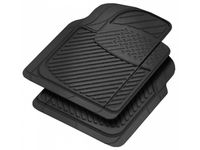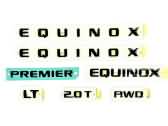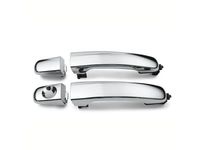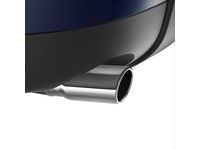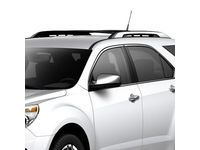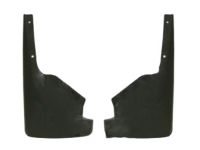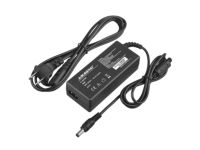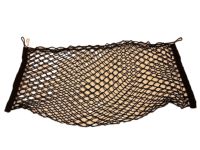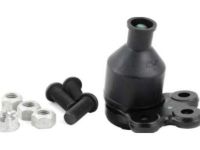Why choose GMPartsGiant
- Large Inventory
The best site to buy Chevrolet Equinox genuine parts for years has been GMPartsGiant.com. We're the best online parts and accessory store for your Chevrolet Equinox. GMPartsGiant.com offers a large parts and accessory inventory to cover all your vehicle's repairs. Feel free to browse through our genuine Chevrolet Equinox parts and accessory catalog to find all your vehicle's needs.
- Fast Shipping Times
All of our Chevrolet Equinox auto parts and accessories are expedited directly from verified dealers and backed by the manufacturer's warranty. Our experienced team ensures the orders are packed to provide quick transit times. The majority of the orders are shipped out within a couple of business days to get the parts out to you as fast as possible.
- Low Prices
Our low prices say it all. You can rest assured that you will always receive unbeatable prices on OEM Chevrolet Equinox parts. Our giant inventory is beyond compare and has everything you need at an extraordinary value not found anywhere else. Whether you're restoring an old vehicle or upgrading the performance of your vehicle you can count on the quality of our products without hurting your bank account.
Popular Genuine Chevrolet Equinox Parts
- Engine Parts View More >
- Front Suspension, Steering Parts View More >
- Fuel System, Exhaust, Emission System Parts View More >
- Brakes Parts View More >
- Transmission - Automatic Parts View More >
- Frames, Springs, Shocks, Bumpers Parts View More >
- Cooling System, Grille, Oil System Parts View More >
- Interior Trim, Front Seat Trim, Seat Belts Parts View More >
Shop Genuine Chevrolet Equinox Parts with GMPartsGiant.com
The Chevrolet Equinox, first launched in 2004, is a prominent mid-size crossover SUV that later transitioned to a compact model. Spanning three generations, each with multiple updates, the Equinox boasts of versatility and technological advancements. The first generation (2005-2009) was manufactured at the CAMI Automotive GM/Suzuki joint venture plant in Ingersoll, Ontario, Canada, with its 3.4 L LNJ V6 engine made in China. The second-generation (2010-2016) featured a gasoline direct injection engine, while the third generation (2018-present) offered three engine types, including a diesel option. Over the years, the Equinox has utilized various transmission systems, starting with the Japanese-made 5-speed Aisin AF33 automatic and the 6-speed GM-Ford 6T70 automatic in the first generation. Later models came with either a 6-speed or a 9-speed automatic transmission. A notable innovation was the new AWD system that allowed the driver to disengage the driveshaft to reduce friction and rotational inertia when the system wasn't required. Dimension-wise, the first-generation model had a 112.5 in wheelbase with standard front-wheel drive and optional all-wheel drive. Subsequent models introduced cosmetic changes and additions, such as new color options and badge placements, with updates to the engine and suspension package in the second generation. Interiors across generations saw options for a dual-player DVD entertainment system, Power convenience package, and a safety package with a lane departure warning system. The latest facelift in 2022 brought in a new front grille, restyled lower fascia, redesigned tail lamps, and bumper. With over 2 million units sold, the Chevrolet Equinox is among the most popular vehicles in the United States.
Despite being a relatively new model, Chevrolet Equinox owners have reported certain design issues. The most notable concern is excessive oil consumption, which some owners reported as needing an oil change every ten days. Alongside poor fuel economy, these issues generally arose around the 75,000-mile mark. The engine may misfire or demonstrate slow acceleration, which could be due to a faulty spark plug leading to lower fuel efficiency or a malfunctioning body control module. The second key problem is noticeable vibration while driving and leaking fluid. Owners reported feeling these vibrations through the steering wheel and seeing fluid leaks on the ground. Unusual sounds when turning or driving over bumps also pointed towards a potentially faulty CV boot or a damaged absorber, both of which could result in vibrations, noise, and fluid leaks. Regular maintenance, including checks on windshield wipers and seat belts, is crucial to extend the vehicle's lifespan and maintain safety standards.
Original equipment manufacturer parts deliver the superb performance and provide top-class durability. That's because they use Chevrolet's official manufacturing techniques, use high-grade materials, and meet the rigorous standards of quality. At GMPartsGiant.com, we take pride in providing the most affordable OEM Chevrolet Equinox parts, like Front End Sheet Metal, Heater, Body Moldings, Sheet Metal, Rear Compartment Hardware, Roof Hardware available online. Our extensive collection of genuine Chevrolet Equinox parts, such as Transfer Case is at your disposal whenever you're in need of a replacement. Rest assured, these parts come with a manufacturer's warranty, guaranteeing their superior quality, reliability, and durability. We invite you to shop confidently with us, as our hassle-free return policy and speedy delivery service are sure to make your shopping experience an enjoyable one.
Chevrolet Equinox Parts Questions & Answers
- Q: How do you remove the power steering pump on Chevrolet Equinox?A: To remove the power steering pump, start by removing the drivebelt and draining as much fluid as possible from the reservoir. Place a drain pan under the pump and disconnect the feed hose and pressure line, plugging or capping all openings to prevent contamination. Then, remove the pump mounting fasteners and carefully guide the pump out through the right fender well, being cautious not to spill any fluid on painted surfaces. To install the new pump, position it and secure it with the mounting fasteners, tightening them to the specified torque. Connect the pressure line and feed hose, ensuring all connections are secure. Install the drivebelt and fill the power steering reservoir with the recommended fluid. Finally, bleed the system to ensure proper operation.
- Q: How to remove a balljoint using the pickle fork/wedge method on Chevrolet Equinox?A: To remove a ball joint, start by loosening the wheel lug nuts and raising the vehicle on jack stands. Remove the wheel and then remove the cotter pin from the ball joint stud and Loosen the nut a few turns but don't remove it yet. Use a ball joint wedge to separate the ball joint from the steering knuckle Finally, remove the ball joint stud nut. For both methods, the installation process involves removing the control arm and drilling out the ball joint rivets. Install the new ball joint using the supplied bolts, making sure to tighten them to the specified torque. The remaining steps involve reversing the removal process.
- Q: How to remove and replace a coolant tank on Chevrolet Equinox?A: To remove and replace a coolant reservoir, Use a suction device to remove coolant from the reservoir. Next, disconnect the upper hose from the reservoir and check for any cracks or hardness, replacing it if necessary. Remove the reservoir mounting bolts and lift the reservoir up, disconnecting the hose from the bottom and plugging it immediately. If any damage is found, replace the reservoir.
- Q: How to remove and install the condenser and radiator on Chevrolet Equinox?A: To remove the condenser on 2007 and earlier models, unclip it. On 2010 and later models, the condenser must be completely removed. Inspect the radiator for leaks and damage, and if necessary, use special techniques for repair. Bugs and dirt can be removed from the radiator by spraying it with a garden hose nozzle from the back side, and it should be flushed out with a garden hose before installation. For installation, guide the condenser/radiator/fan assembly into position, ensuring that the rubber mounts on the bottom are properly seated into the support. Tighten the radiator and air conditioning condenser bracket bolts securely. Fill the cooling system with the proper mixture of antifreeze and water, start the engine and check for leaks. Allow the engine to reach normal operating temperature, then recheck the coolant level and add more if required. Finally, check the transaxle fluid and add more as needed.




















































